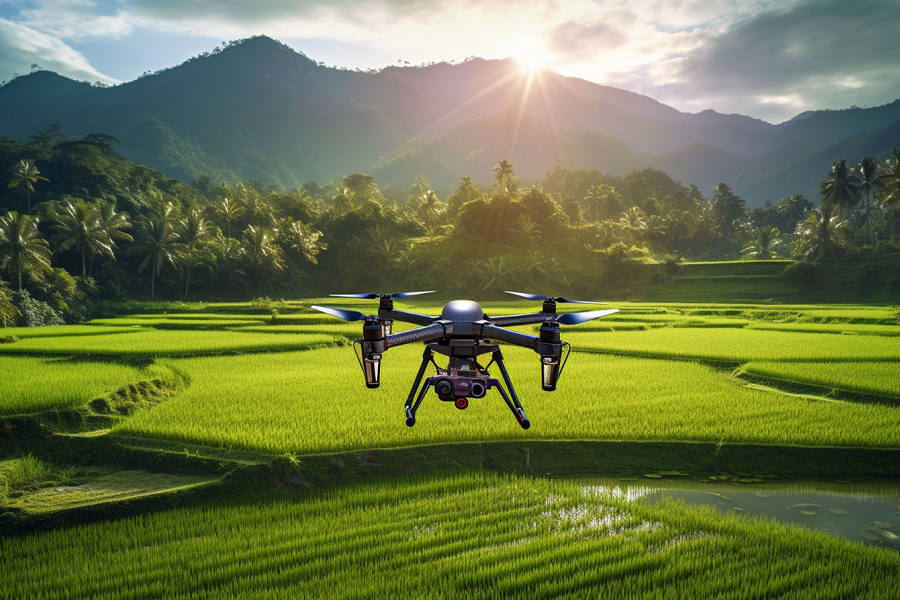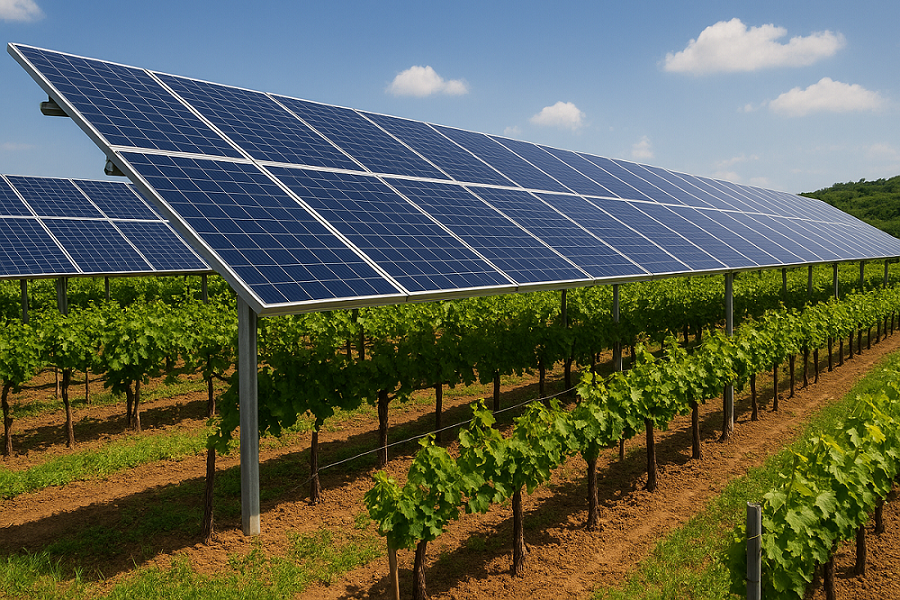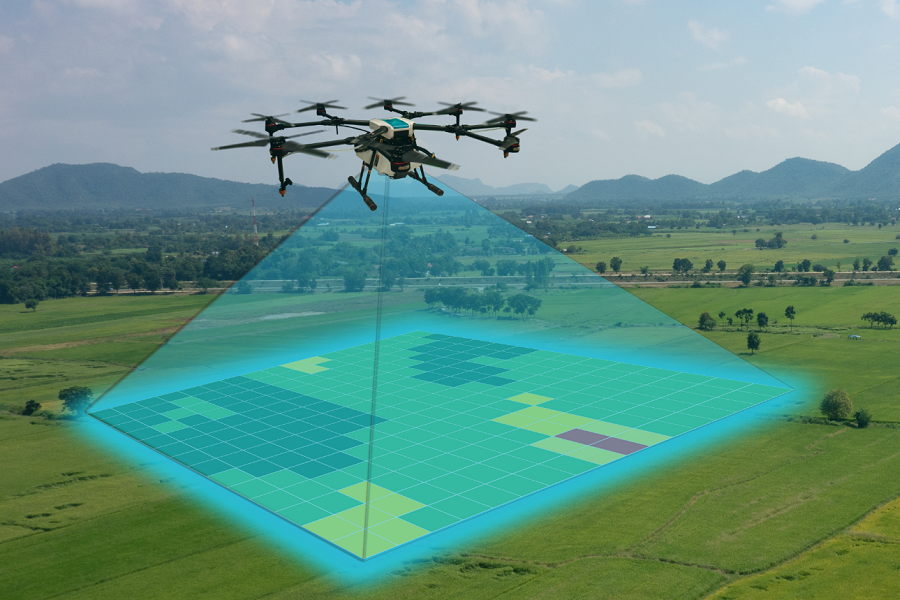by Antonio Donnangelo
Share
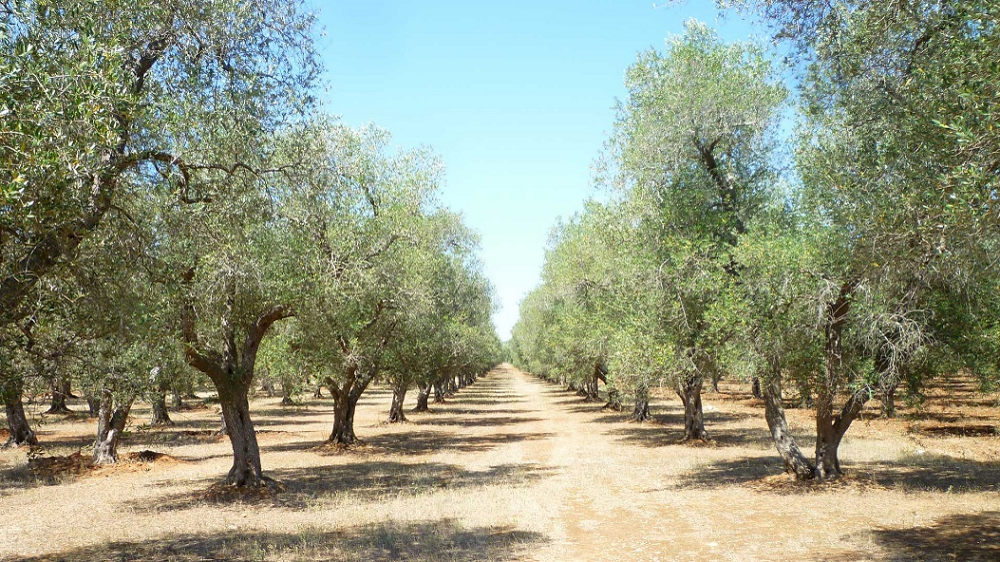
Introduction
Olive growing is a millennia-old practice that deals with the cultivation of olive trees (
Olea europaea
) for the production of table olives and, especially, olive oil. This agricultural sector is of great economic and cultural importance in many regions of the world, particularly in countries around the Mediterranean basin, becoming an essential part of the culture and economy of many communities.
In recent years, the olive supply chain has been going through major transformations, including competition with new producing countries internationally, the emergence of emergencies related to plant health, and changes in climatic conditions.
To effectively address these challenges, Agrobit makes available a range of innovative services and tools that support companies in managing the olive grove and optimizing the quality of the final product.
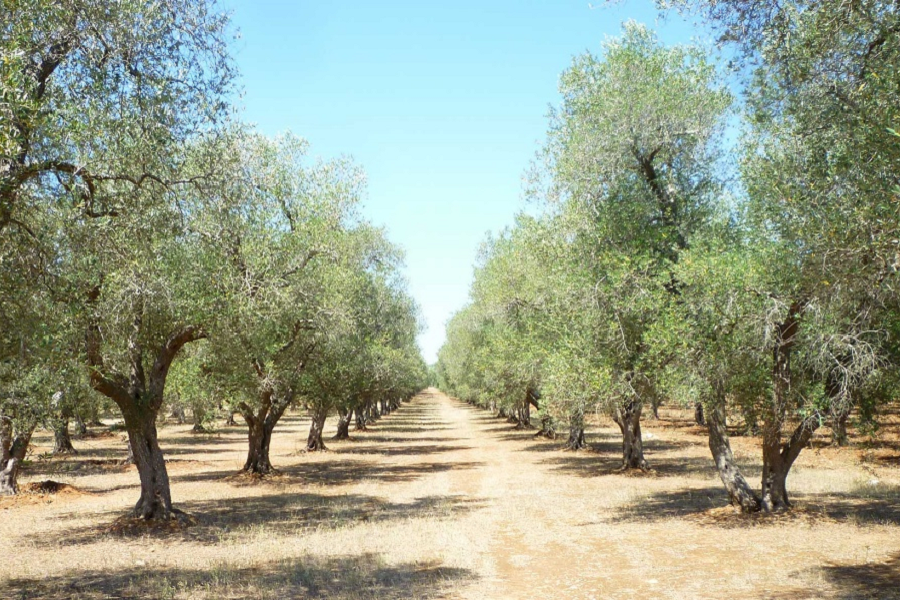
Fig.1: olive grove
iDrone: variability maps generated by drone
Through the analysis of visible (RGB), multispectral and/or thermal images taken by drone, it is possible to reconstruct thematic maps of the olive grove, such asNDVI (Normalized Difference Vegetation Index) maps , an important tool used to monitor and assess olive grove vigor (Fig. 2).
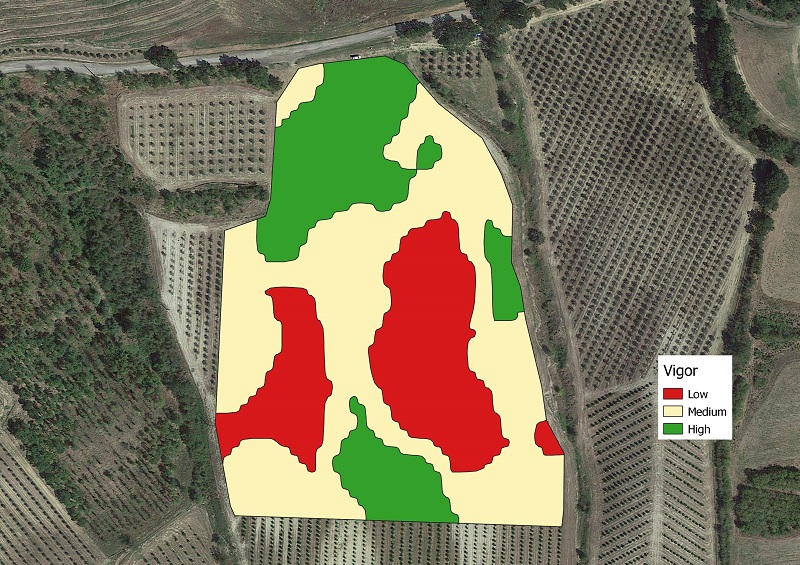
Fig.2: vigor map of an olive grove in three classes: low, medium, high
Maps can be used for a variety of purposes:
1. Rationalized phytosanitary treatments
Vigor maps make it possible to identify and characterize variability in the field; this allows zoning maps to be created that, once loaded onto variable treatment machines (VRTs), allow treatments to be concentrated in the most vigorous areas and less product to be administered in the least vigorous areas, optimizing the use of water and pesticides.
2. Differentiated Fertilization
Through vigor maps, which identify variability in the field, you can tailor fertilization to the specific needs of your olive grove. This allows for more precise nutrient management, reducing waste and improving distribution proportionally to areas where it is most needed. When done correctly, differential fertilization based on vigor maps contributes to theoptimization of fertilizer use. In fact, by distributing smaller amounts of fertilizer in already vigorous areas and larger amounts in less vigorous areas, nutrient distribution in the field is improved and variability is reduced.
3. Irrigation optimization and water stress management.
Through drone-mounted thermal chambers, the following can be generated Temperature maps for managing water stresses consciously. These maps provide information on the temperature of olive trees and soil, helping to Identify areas prone to water stress. These critical areas can be identified in a timely manner to take preventive actions to define targeted irrigation scheduling, allowing the olive grower to make more informed decisions about irrigation to A more conscious use of the water resource.
The Crop Water Stress Index (CWSI). is an indicator used in agriculture to assess the level of crop water stress (Fig. 3). The maps can indicate areas of the olive grove that need irrigation or have drainage or waterlogging problems, allowing targeted management of water resources to improve plant well-being by reducing the risk of improper irrigation management.
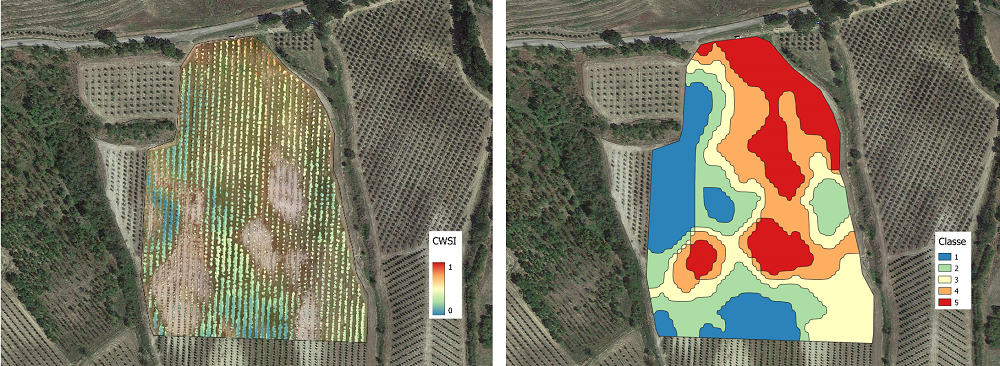
Fig.3: Water stress map of an olive grove (CWSI). Left, water stress of leaf canopies (in red, major water stress; in blue, water well-being). Right, zonation of water stress obtained by reclassifying and spatializing the CWSI values. Values range from 1 to 5, that is, from lower to higher stress values.
iAgro: precision olive growing from a smartphone
Agrobit’s solutions also include.
iAgro
, the first mobile
site-specific DSS app that can optimize phytosanitary treatments and create vigor maps
of the olive grove simply by using your smartphone.
With iAgro,
through a guided photographic scan of an olive plant
(Fig. 4) several parameters can be measured quickly and objectively, in particular:
The height, thickness, and crown volume
of the scanned plant;- the Leaf Area Index(LAI);
- the Leaf Wall Area(LWA);
- the Tree Row Volume(TRV);
- The optimal dose of water for phytosanitary treatments at each phenological stage.
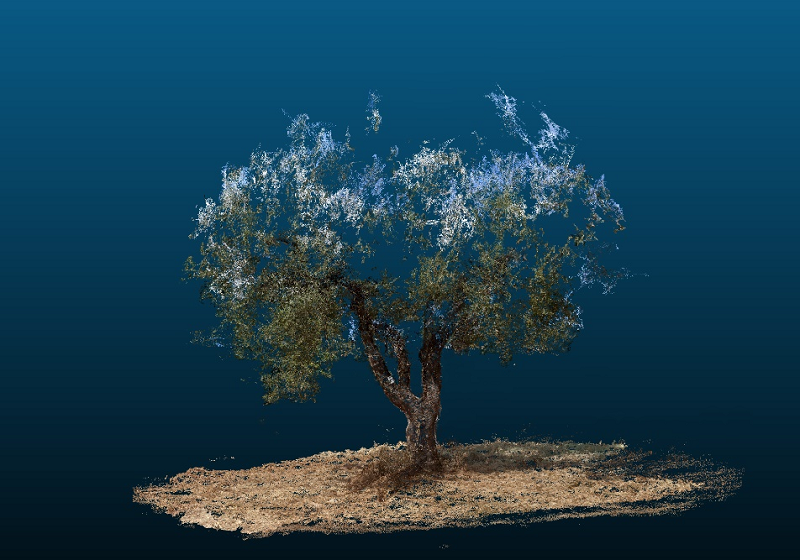
Fig.4: 3D point cloud of an olive tree generated by the iAgro app
By sampling a sufficient number of well-distributed plants in the field (at least 5 points per field), the app automatically generates vigor maps (LAI index), which can be used to optimize fertilization and prescription maps for variable and optimized phytosanitary treatments, based on the actual needs of the olive grove and at each phenological stage detected (Fig. 5).
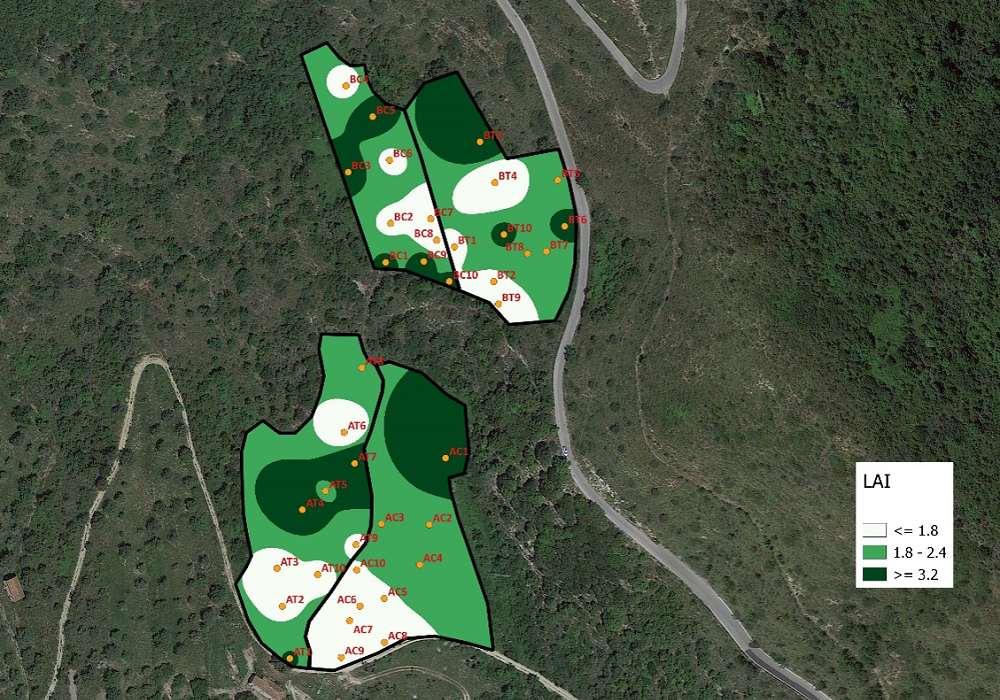
Fig.5: Vigor map (LAI index) in 3 classes generated by the iAgro app (in yellow, the points scanned with the app), which can be used to optimize fertilization. The whiter areas correspond to lower vigor than the greener areas, which instead have higher vegetative vigor.
Based on the type of treatment and farm sprayer, the app will be able to create a prescription map for the correct dose of water and pesticide to distribute (Fig. 6), always respecting the manufacturer’s label. Thanks to iAgro, it is possible to save up to 60 percent of water per treatment and better distribute pesticides, with positive economic, environmental and social implications.
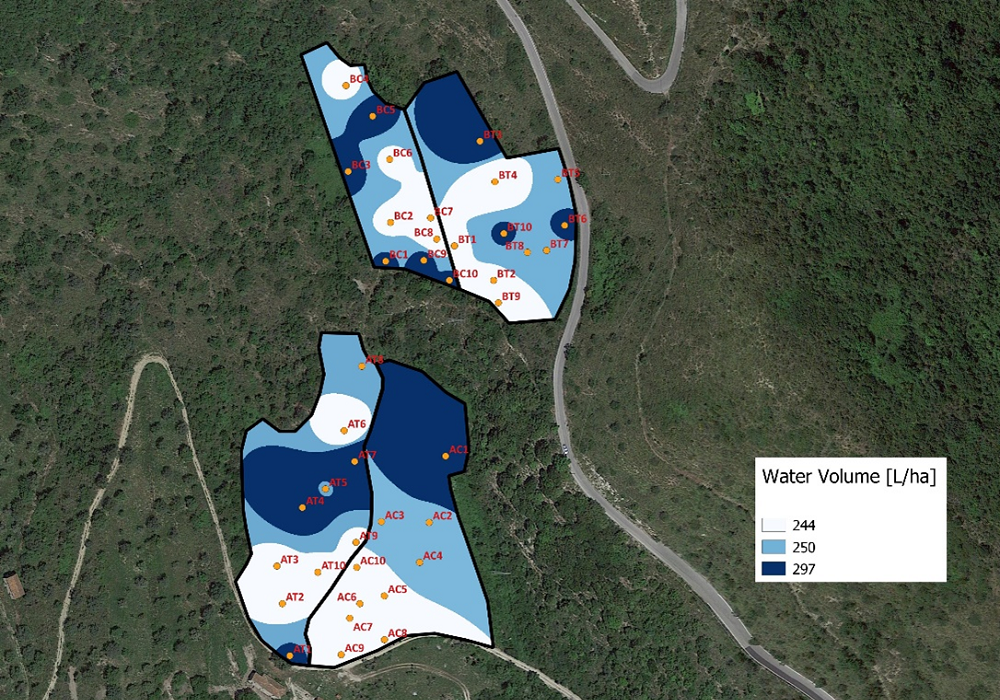
Fig.6: Prescription map of water doses (l/ha) in 3 classes generated by the iAgro app (in yellow, the points scanned with the app), which can be used for optimization of phytosanitary treatments, including by uploading it directly to variable rate machinery (VRT)
Weather stations, DSS and forecast models.
In the context of quality olive cultivation, weather stations and forecasting models are irreplaceable tools that go to constitute true decision support systems (DSS) for agronomic decisions. Their importance is crucial as they provide essential data for optimal olive grove management and informed decision making based on information from the field (soil and microclimate).
Weather stations collect weather data in real time, such as temperature, humidity, precipitation, leaf wetness, wind speed and direction, etc., while forecast models use these data, along with accurate weather forecasts and mechanistic models that are based on olive tree biology, to return useful information for decision support such as:
- the phenology of the crop (stage of development or stage of maturity);
- the risk of pathogen infestation at each point in the crop cycle;
- Nutritional and water requirements.
An example of DSS for olive growing is Oliwes, a solution from Agricolus, in which come a range of information that is very useful to the farmer, among which we find:
Phenological model:
Forecasting phenology to assess the needs of the olive grove at each stage of development;- Estimation of irrigation needs: to intervene when necessary with the optimal water supply;
- Fertilization model: calculation of total nitrogen, phosphorus and potassium requirements to obtain with suggestions on fertilizer doses to be made;
- Predictive models of diseases and harmful insects (olive fly): it is now well known that among the adversities of olive growing, the olive fly poses a significant threat to olive yield and quality. Females of this fly lay their eggs inside the drupes, causing damage to the pulp by feeding larvae and inducing premature fall of the affected fruit. In Oliwes, it is possible to predict these infestations in order to take early action, thanks to the model of fly mortality , which describes the daily and weekly mortality level of young fly forms based on the minimum and maximum temperatures measured by the weather station, and the fly development model, which estimates the distribution of the fly population at various phenological stages, then the trend of individual stages over time and the number of annual generations of the insect, using hourly temperature data (Fig. 7). These predictions enable theolive grower to take preventive measures and treat more efficiently and effectively.
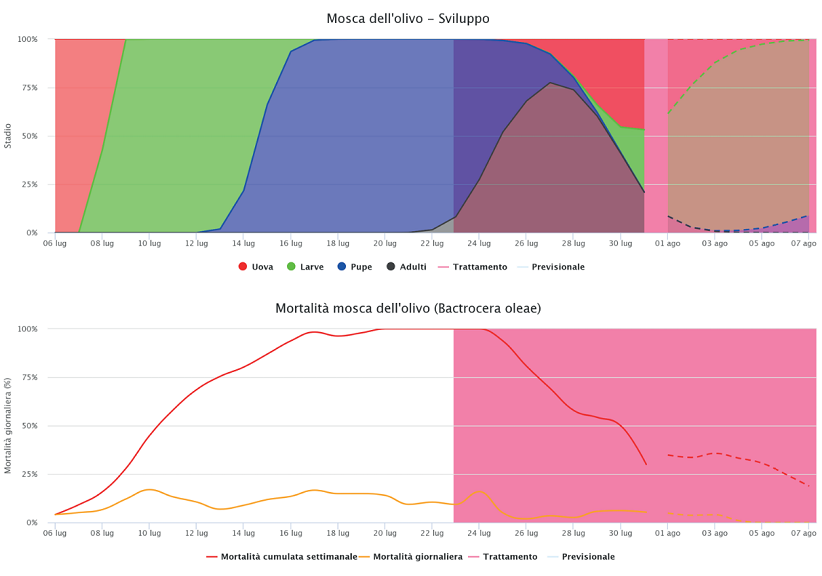
Fig.7: Prediction model of the development (top) and mortality (bottom) of olive fly
Conclusions
Management of the olive grove through pesticides and fertilizers has a significant impact in the economic and environmental balance of a farm. It is important to implement the rationalization of agricultural practices that characterize the management of the olive grove through tools to decrease its environmental impact, making the farm more sustainable and competitive in the market and in line with new regulations (European Green Deal and Farm-to-Fork Strategy).
The use of olive grove vigor maps, generated with the iDrone service or independently with the iAgro app, enables farmers to take a more focused and sustainable approach to olive tree management, improving the quality of the end product and reducing wasted resources. This operational strategy stands out for its remarkable robustness in delineating the specific characteristics of the olive grove, focusing in particular on defining the variability naturally present in the field, enabling the farm to consolidate an increasingly precise identity and stand out in the marketplace.
The use of weather stations and forecasting models allows olive growers to make science-based decisions and reduce risks, improving olive quality and yield and, consequently, oil production. In the olive sector, for which thermal variations affect all physiological processes that govern phenological and physiological development, the ability to predict and constantly monitor this type of information is crucial to Ensure high control over olive quality and adequate productivity. Using weather stations and forecasting models, olive growers can act at optimal times optimizing defense operations and resource utilization, reducing waste and improving production efficiency.

